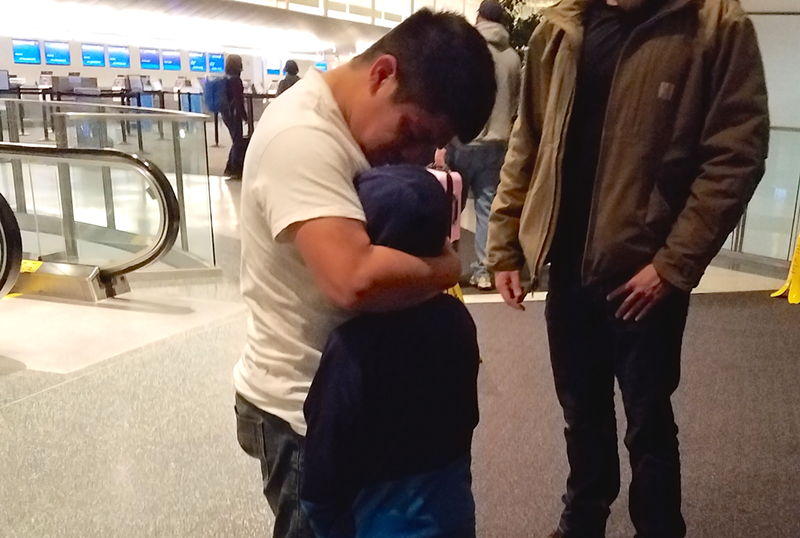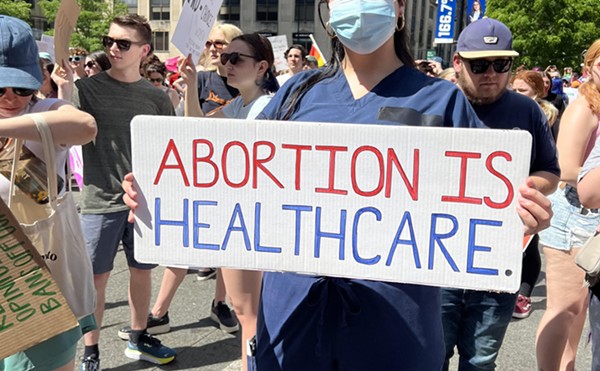
It is about four in the morning when two Immigration and Customs Enforcement officers, both tall, bearded men in khaki-colored work jackets and jeans, lead Benjamin Yat-Xicol by the arm through the mostly-empty departures terminal at the Cincinnati/Northern Kentucky international airport.
The 28-year-old is wearing a plain white T-shirt despite the chilly evening and clutching a clear plastic bag full of his belongings.
He is about to be deported. But first, he will be reunited with his son, whom Yat has not seen during the last eight months he has been in detention.
The younger of the two ICE officers stays with Yat as the older officer peels off to check him in for his flight.
"Cinco minutos," the officer tells Yat, sitting him down on a couch and standing close while the two wait.
Yat's deportation will likely be one of hundreds of thousands this year as the administration of President Donald Trump continues an aggressive approach to undocumented immigration. Trump and his supporters say that approach is necessary to preserve American jobs and combat illicit drugs entering the U.S.
On Feb. 15, Trump promised to declare a national emergency in order to construct a border wall with Mexico, one that he promised to build as part of his 2016 campaign. Whether or not that wall is ever constructed, Trump’s administration continues to ramp up immigration enforcement.
Last year, the Department of Homeland Security sought the removal of more than 300,000 people, according to data from Syracuse University’s Transactional Records Access Clearinghouse, which combs data provided by DHS. That’s the highest number of deportation orders sought by DHS since at least 1992, when TRAC began.
Meanwhile, apprehensions of undocumented immigrants at the southern border have decreased more than 50 percent since that time and are at their lowest levels since 1971, according to Department of Homeland Security data.
The chain of events tying deportation arrests to eventually being deported is complex and can take a long time, especially given the massive backlog in immigration cases faced by U.S. courts. Actual deportations under the Trump administration are still lower than they were under the tenure of President Barack Obama, but they are rising quickly, especially from areas that aren't around the U.S.-Mexico border. Interior arrests under Trump have surpassed the numbers made during Obama's final two years in office.
About 45 percent of deportees last year originally came from Central American countries like Honduras, El Salvador and Yat's native Guatemala, where skyrocketing crime and pervasive poverty have pushed migrants out by the thousands. After Mexico, Guatemala is the country of origin for the highest number of deportees so far this year.
Yat and his son are from Coba, a predominantly-Mayan village of about 1,300 in the Yucatan Peninsula that depends mostly on tourism drawn by nearby Mayan ruins. Yat had significant trouble finding employment there and elsewhere in Guatemala, he says, and decided to make the difficult, dangerous trip across the Mexican and U.S. borders with his son, Danny, leaving the rest of his family behind with a plan of sending money back for them.
“I had to leave because my children were dying of hunger,” he told an immigration attorney working on his behalf.
Economic reasons aren’t enough to win asylum in the U.S., though others from Guatemala have won asylum when they have been able to prove their lives are in danger from specific threats like political or gang violence.
The suffering Yat describes is a common experience in his home country. By the Guatemalan government’s own measures, the share of the country’s population living in poverty grew from 51 percent in 2009 to almost 60 percent in 2014, and has continued rising since.
In many Central American countries, violence is also a huge problem.
In 2014, Guatemala had the 10th-highest murder rate in the world. Simply crossing a border doesn’t offer escape: Honduras and El Salvador, to the south, have the world’s highest and second-highest murder rates, respectively, and Belize, to the east, has the world’s seventh-highest.
All the economic hardship and violence has driven much of the contemporary unauthorized immigration Trump ran against in 2016.
In Guatemala, much of the unrest has roots in the country’s brutal history. For 36 years beginning in 1960, a bloody civil war raged in the country as leftist guerrillas sought to overthrow a dictatorial government. During that war, government-affiliated military forces undertook a well-documented genocide against indigenous Mayan citizens of Guatemala.
The American government had some role in the strife. The U.S. backed the ruling regime, sending military and economic aid until at least the late 1970s. The United Nations brokered a peace agreement in 1996, but hardships have persisted. Today, many Guatemalans coming to Cincinnati are of Mayan descent, including the Yats, who primarily speak an indigenous dialect.
“You had just entire Mayan communities burned to the ground,” Eastern Michigan University sociologist Dr. Maria Garcia, who has researched extensively in Guatemala, told CityBeat in 2016. “To expect economic recovery after that extreme violence just isn’t reasonable. Those patterns of economic and systemic racism continue to exist today.”
Two borders away, political pressures fueled by worries about drugs, crime and jobs have pushed America’s immigration enforcement efforts to aggressive new highs.
Trump and other supporters of hardline immigration prohibitions have highlighted alarming stories about immigrants who have committed murders and other unspeakable crimes while in the U.S.
But about 90 percent of the deportees last year, like Yat, are being removed solely for violating immigration law, a departure from past policy and part of a widespread undocumented immigration crackdown that began with a January 2017 Trump executive order.
That stance has hardened further in 2019. Earlier this year, Trump and Congress were locked in a bitter battle over the president’s demand for a $5.6 billion border wall that triggered the nation’s longest-ever government shutdown.
But Congress passed a budget that doesn’t include the funding for the wall.
Trump, in turn, vowed to declare a national emergency over immigration so he can spend the billions needed to construct the barrier he has been promising supporters since he made immigration a keystone issue of his 2016 presidential campaign.
That promise has been dominating headlines across the country. But for immigrants like Yat, other concerns are more immediate.
As he waits with the ICE agents in the airport lobby, a car driven by an immigration attorney and carrying his 8-year-old son Danny glides south through the night on I-75. The trip from the northern suburbs of Cincinnati passes the rooflines of still-sleeping urban neighborhoods and the towering downtown offices before crossing the glassy, swollen Ohio River to Northern Kentucky. It is a final flash of an America Danny will likely not see again soon.
He does not want to leave the United States, and sits wordlessly in the car as it speeds him toward his father, the waiting airplane and the country both of them fled less than a year ago.
Sitting next to him are a woman in her 30s and her daughter, who is a couple years older than Danny. They took Danny and his father into their home in a suburban Cincinnati apartment complex seven months ago, when the two first arrived in the U.S. from Guatemala.
“I had an extra room, so I let them come stay with me,” Danny’s caretaker, who asked not to be named, says. “After 20 days, (his father) got picked up, so I took over after that.”
Yat was arrested when police pulled over a van full of workers headed to a construction site in Lebanon. ICE agents have arrested about 3,900 people in Ohio since Trump took office, including 179 in Butler County, where Yat was picked up. ICE placed a detainer on him soon after, and he spent months in the Butler County Justice Center before he was transferred to a federal detention center in Morrow.
Now, Yat is being sent back to Guatemala, and Danny will come too instead of facing life in a strange country without his father or documentation.
The prospect is visibly difficult for Danny’s caretaker, who has risked a lot to come with them to the airport.
“I’m going to stay in contact with them,” she pledges.
The group, which also includes an immigration attorney, arrives in the airport lobby about 10 minutes after Benjamin and the ICE agents. Yat embraces Danny, who says little as tears stream down his face.
Danny’s group has come bearing gifts: a gym bag full of additional belongings Yat hasn’t seen since ICE arrested him, another pair of brown leather shoes to replace his beat-up sneakers and some cash.
There are precious few minutes left, and Yat must try to decide which of his things will go into his makeshift luggage and what he will throw away with the garbage bag he brought. Crouching just inside the door of the airport lobby, he sorts through a pink folder of official-looking papers in Spanish and hands some to Danny, fishes out some clothes and more papers and eventually consolidates everything into one bag.
The ICE agents ask the immigration attorney if Yat has a phone.
“You know, so he can’t…” one agent says, making a texting motion with his hands.
Yat fishes a smart phone out of a plastic bag and places it in a manila envelope one of the agents is holding. The agents, who work out of an ICE office in Blue Ash, will escort the Yats to the plane, then watch it take off.
Yat's phone will be handed off to other agents waiting for him at the airport gate in Miami, where the flight will stop briefly. He will get the phone back in Guatemala.
The woman who took care of Danny for eight months talks quietly with the Yats as tears well up in her daughter’s eyes. The immigration attorney speaks briefly to Benjamin.
Then, the ICE officers, Yat and Danny, who is trailing slightly behind, walk toward the airport’s security gates. It is time to go.





